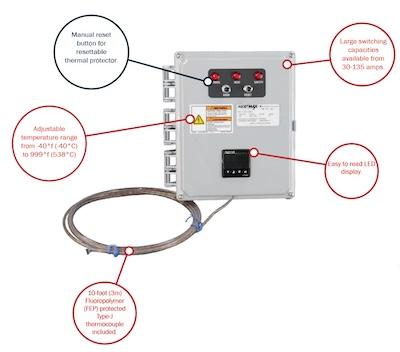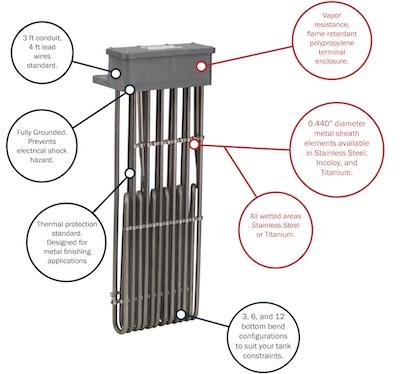Maintaining optimal temperatures in chemical baths is crucial for metal plating efficiency.
 Zach HornDue to their superior responsiveness and efficiency, many platers use electric immersion heaters for this job. However, like any critical equipment, they are subject to wear and tear, particularly when directly heating aggressive chemical solutions or high temperatures.
Zach HornDue to their superior responsiveness and efficiency, many platers use electric immersion heaters for this job. However, like any critical equipment, they are subject to wear and tear, particularly when directly heating aggressive chemical solutions or high temperatures.
Neglecting routine maintenance can lead to costly downtime, inefficiencies, and even equipment failure. In this guide, we’ll walk you through some of the most common issues with electric immersion heaters. We will also provide practical troubleshooting tips and advice on what preventative maintenance you can do to avoid this.
Understanding these issues and how to address them can extend the life of your heaters, enhance performance, and ultimately save you time and money.
Maintenance: Dealing with Build-up and Sludge
Some applications have lots of debris and sludge that build up within the tank. If you are using an electric immersion heater, it is highly advised to check the heater often to see if any sediment is building up on the elements.
Buildup on the element can prevent the heat produced from conducting into the solution, reducing its performance and potentially overheating the element, leading to its premature failure. This is easily avoided by adding a maintenance schedule to inspect and clean any debris or buildup off the heating elements.
While we recommend using a power washer or mild cleaning solution, it is best to confirm specific cleaning instructions recommended by your chemical provider. Using wire brushes or chisels and hammers is highly advised against, as these methods can damage the heating element insulation, which can cause a short circuit.
Regular inspections and maintenance of the heating elements help the heater last longer and maintain its efficiency.
Not getting up to Temperature
 Have you or other members of your team noticed a change or reduction in your heater's performance? Your first step should be to disconnect power from the heater, remove it from the tank, and do a visual inspection. If you don’t notice any buildup or other signs of damage, you can move on to checking the inside of the heater using Ohms Law.
Have you or other members of your team noticed a change or reduction in your heater's performance? Your first step should be to disconnect power from the heater, remove it from the tank, and do a visual inspection. If you don’t notice any buildup or other signs of damage, you can move on to checking the inside of the heater using Ohms Law.
While keeping the power disconnected, use an ohms meter to read the resistance of the heater’s circuit. Sharing your readings with the heater manufacturer will allow them to check whether the heater is operating at the designed output or underperforming.
Another possible cause is not the heater but rather an issue with the control. The most common cause is when the solution penetrates the fluoropolymer sleeve that protects the sensor. If a chemical solution comes into contact with the sensor, it can interfere with the signal it transmits to the control, making the temperature readings erratic.
If you see a solution inside the fluoropolymer sleeve, it is time to ask your distributor for a replacement sensor. If the sensor is in good condition, the sensor from the control may have lost some of its calibration. This can be confirmed by placing a thermometer as close as possible to where the sensor is reading from and holding it in place for 20 minutes. You can set an offset if the sensor is reading consistently high or low. The offset can be adjusted to your temperature difference, leading to an accurate reading. Consult with your control’s manufacturer for instructions on programming an offset.
If there are no issues with either the heater's output or the controls’ temperature readings, any issues with heat-up time may be caused by other factors that may have changed, such as ambient temperature, missing lid, etc.
Thermal Protectors and Nuisance Tripping
 All metal plating heaters come standard with built-in thermal protectors, whether replaceable or resettable.
All metal plating heaters come standard with built-in thermal protectors, whether replaceable or resettable.
With replaceable thermal protectors, nuisance tripping can happen, which means the thermal protector is cutting power to the heater before reaching temperature. This can be due to a few reasons like the current thermal protector not being rated for the temperature to be achieved, or maybe you purchased a used plating line, and the thermal protector is towards the end of its operational life. This can be confirmed by checking the continuity between the thermal protector leads.
Standard thermal protectors are provided for solutions up to 180°F. If your operation temperature is higher, ensure you communicate the temperature and tank material to your supplier so that a higher-temperature-rated thermal protector can be accommodated.
Fusing
Having a qualified electrician install your heaters and other equipment is always urged, as it ensures proper installation.
If a heater is not properly fused, you can expect to experience issues when an element fails or shorts out. Proper fusing will cut power to the heater the moment it detects a ground short.
Heater Lifespan
Many factors contribute to the life of an immersion heater, including the operation temperature, solution concentration, how long the heater runs, and how many times it is cycled. A maintenance schedule should consist of frequently checking the heating element for any buildup, checking all electrical connections, and ensuring proper voltage is applied to the heater.
If you are doing all of these but still would like to get more out of your immersion heater, speak to a heater manufacturer. We may be able to advise you on whether an alternative heater design could provide a longer life or require less regular maintenance.
Zach Horn is with Heatmax Heaters. Please visit https://heatmaxheaters.com.



































